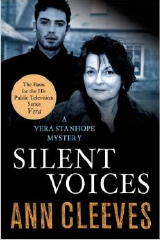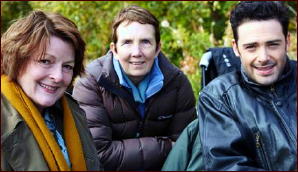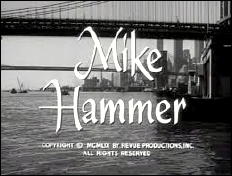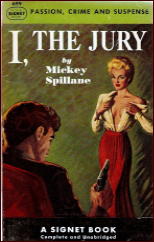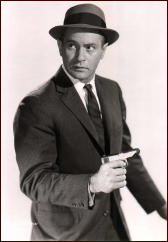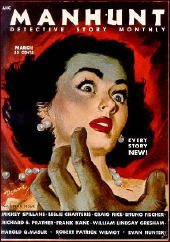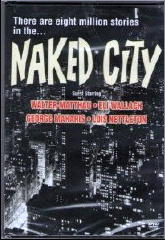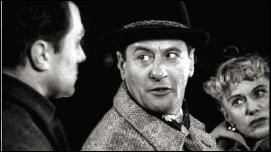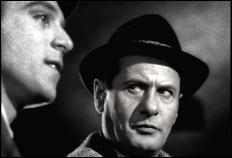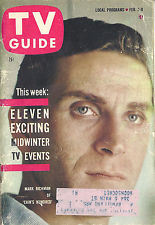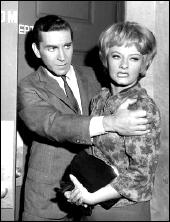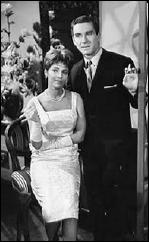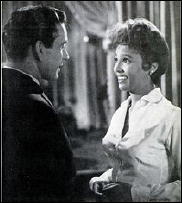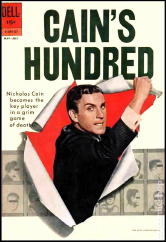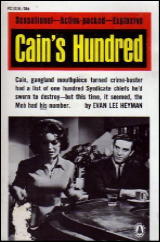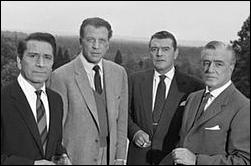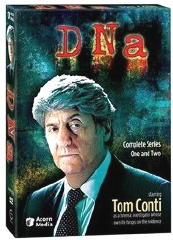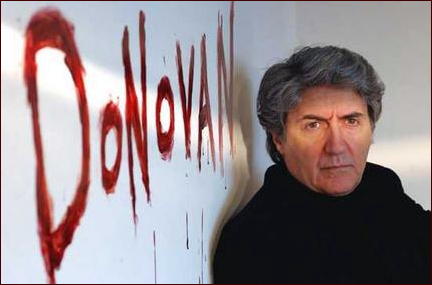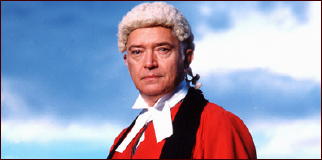Tue 15 Jul 2014
A TV Review by Michael Shonk: COUNTERSPY and DAVID HARDING, COUNTERSPY.
Posted by Steve under Reviews , TV mysteries[13] Comments
COUNTERSPY and DAVID HARDING, COUNTERSPY. TV episodes, 1958 and 1959. Bernard L. Schuberg Presentation / Telestar. Executive Producer: Herbert E. Stewart. Based on the radio series Counterspy (1942-1950).
COUNTERSPY. (1958) Written by Jack Anson Fink. Directed by Ralph Francis Murphy. Cast: Don Megowan as David Harding. Guest Cast: Brad Johnson, Gerald Milton and Phyllis Stanley *** A former WWII British Navy frogman puts the fins back on to help Unit C uncover the new advance by the Russians in ship navigation.
The story is weak with unbelievable characters and plot. No Russian Admiral would treat a top-secret device so carelessly while ignoring the head of security. Slow paced with a writer’s trick needed to supply tension and a lackluster soundtrack add to the episode’s flaws.
The episode has been posted on YouTube many times including here.
This is the most commonly seen episode of COUNTERSPY (this is from Alpha Video DVD collection) and may be the only surviving episode left to watch. It is commonly believed to be an unsold pilot, but the episode ends with Don Megowan (THE BEACHCOMER) doing a tease about “next week’s†episode. That seems unlikely for a pilot. Reliable TV spy historian Craig Henderson wrote at his website For Your Eyes Only (*) — a must visit for spy fans — there was a series with Megowan.
According to “Broadcasting” magazine (April 14, 1958) filming of COUNTERSPY had begun the week of April 7, 1958. The half-hour TV-film series would shoot in Hollywood and in 26 different locations throughout the world. Producer Bernard Schubert had budgeted 39 episodes at more than $35,000 for each TV-Film episode. It would be syndicated through Schubert’s company Telestar.
From “Broadcasting†(June 16,1958), “Telestar Films, New York, announced last week it is releasing three new half-hour tv (sic) film series for syndication to stations. They are COUNTERSPY, an adventure-suspense series filmed on location through out the world…â€
For the curious the other two were PAROLE and yet to be titled country music show. PAROLE would become a series. TV series YOUR MUSICAL JAMBOREE was probably the country music show mentioned. According to the article, COUNTERSPY was to be released in fall of 1958.
Bernard L. Schubert was a minor player in the TV-film syndicated market that played a major role in television during the 1950s. Schubert produced such TV series as ADVENTURES OF THE FALCON, AMAZING MR MALONE, MR AND MRS NORTH, TOPPER, CROSSROADS, TV READER’S DIGEST, and WHITE HUNTER.
Craig Henderson’s website mentions a remake of COUNTERSPY. Thanks to YouTube, I was able to find the pilot remake done by Schubert with Reed Hadley (RACKET SQUAD, PUBLIC DEFENDER) as David Harding.
DAVID HARDING, COUNTERSPY. 1959). Written by Stanley Kapner. Directed by Justin Addiss. Cast: Reed Hadley as David Harding. Guest cast: Christopher Dark, Lilyan Chauvin, Ross Elliott and Vito Scotti. *** A man in a small French village risks everything to help David Harding find two missing American agents.
An improvement over Mcgowan’s version of COUNTERSPY, this was better produced featuring good use of a (now cliché) soundtrack, with a story full of tension, violence, mystery and even a spy gadget. The opening with Hadley as Harding giving a pledge perfectly fits the period’s reaction to the Cold War and is an improvement over the written scroll of the earlier version.
In January 26, 1959 issue of “Broadcasting†producer Bernard Schubert announced a new half- hour TV series COUNTERSPY would be released in May.
Why remake COUNTERSPY less than a year later? Commie-fighting heroes was one of the most popular sub-genres on TV during the fifties. One can understand Schubert’s reluctance to give up on David Harding. COUNTERSPY was not the only remake on his schedule that year.
In “Broadcasting†(February 2,1959) Schubert’s Telestar announced the filming of the pilots for two possible series, COUNTERSPY and THE NEW ADVENTURES OF MR. AND MRS. NORTH.
The June 15, 1959 issue of “Broadcasting†reported Telestar had three series about to start filming in Hollywood. They were COUNTERSPY, ALEXANDER THE GREAT, and THE NEW ADVENTURES OF MR. AND MRS. NORTH. For the curious ALEXANDER THE GREAT was to be based on the “Saturday Evening Post†short stories about an earthworm tractor salesman.
“Broadcasting†(September 7, 1959), reported 39 episodes of DAVID HARDING, COUNTERSPY starring Reed Hadley would be available for national syndication but no date was given.
September 28, 1959 “Broadcasting†had an odd item about Schubert’s plans to sneak preview episodes from Telestar’s three forthcoming TV-film series. The three series would be DAVID HARDING COUNTERSPY, ALEXANDER THE GREAT, and DAVID HARUM (another attempt by Schubert to adapt a movie turn radio series for TV, Chill Wills was to star as Harum). Plans were to feature as many as six episodes from each series.
The previews would take place in TV station studios or local movie theatres in six key U.S. regions. The audience would fill out “comment cards†that would influence the series still in production. The first sneaks were planned for late September. Does anyone know if this happened?
David Harding began as the main character in the radio series COUNTERSPY (1942-50 Blue/ABC, 1950-53 NBC, 1953-57 Mutual) and was created by Phillip H. Lord (SETH PARKER, GANGBUSTERS).
COUNTERSPY was also adapted for two films, an attempted film series by Columbia Studios. The films were DAVID HARDING COUNTERSPY (1950) and COUNTERSPY MEETS SCOTLAND YARD (1950).
While I believe the Reed Hadley pilot never went to a full series, I do believe there was a short-lived Megowan series. Are there episodes of the series still out there? This is too common a question for those of us interested in early television.
There are too many forgotten TV series, especially those syndicated, and too much misinformation in the books and databases devoted to the subject. Thanks to TV-Film collectors we continue to find the shows themselves but despite what we see and learn, common knowledge continues to rule over facts (not unusual in today’s world).
IMDb does its best, but its episode indexes are near worthless, and the site is riddled with errors such as the Reed Hadley version of COUNTERSPY being listed at IMDb under DAVID HARTMAN, COUNTERSPY (1955) instead of DAVID HARDING, COUNTERSPY (1959). The Hadley bio on IMDb has him playing the character David Harding on DAVID HARTMAN, COUNTERSPY.
One can only hope someday one of the TV archives such as Museum of Broadcasting, Paley Center and UCLA Film-TV library will index for the Internet (with episodes’ credits, plots and dates if available) the TV shows they are storing. While legally they can’t put the shows on the Internet, they should do an Internet database and end the mysteries, get rid of the accepted misinformation, and fill in the blanks of TV’s past.
(*) FULL DISCLOSURE: Back in 1973-74 I wrote for two issues of Craig Henderson’s FYEO (FOR YOUR EYES ONLY) fanzine.
